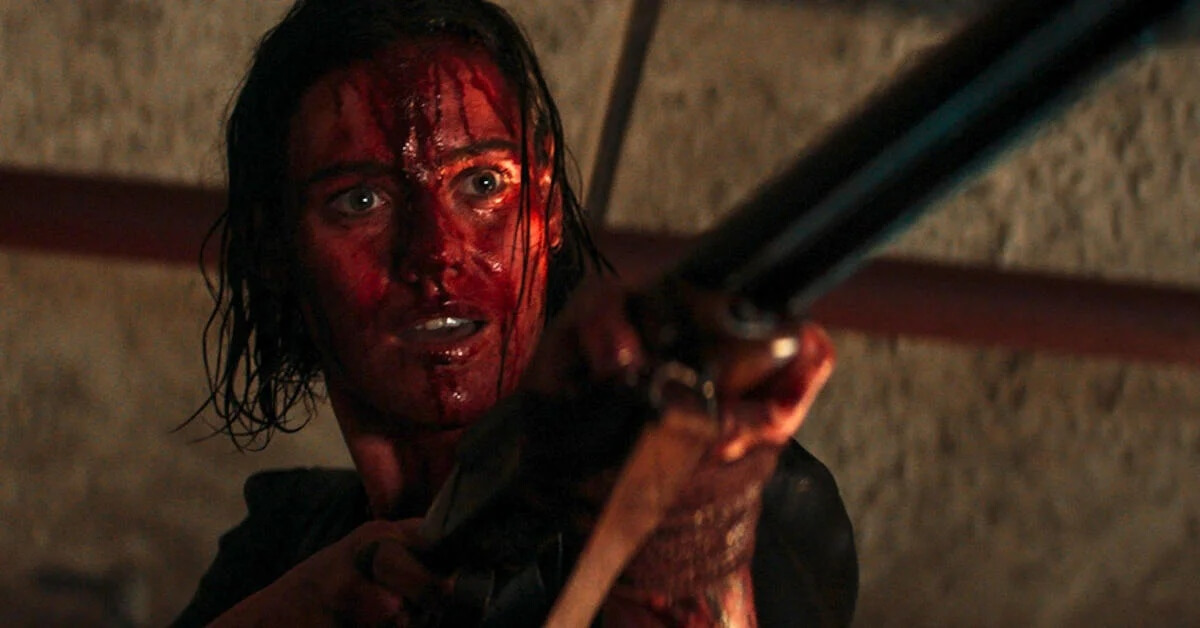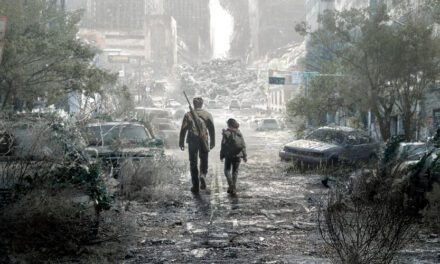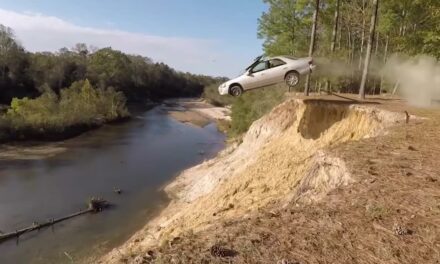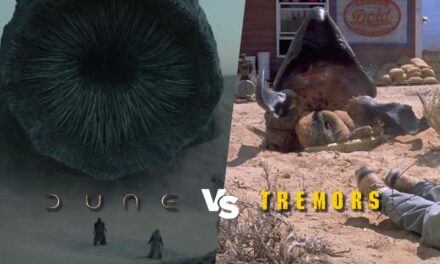Disclaimer: If you don’t enjoy seeing blood, thinking blood, or talking about blood: Please gently back out of the doorway of this article now and quietly escape into the night.
“What do you do for a living?” the stranger on the bus asks the effects artist next to them.
The artist looks up from deep thought:
“Oh, I help murder people on-screen.” They smile. “I’m really good at it.”
The art of good movie blood is a history lesson, a cultural marker, and a stylistic crescendo reverberating through the Sydney Opera House all at once. It goes back to the olden days when a theatre actor used a hidden red handkerchief to show blood, right up through Dick Smith’s Karo syrup and food dye recipe, to the CG droplets that splatter your screen today.
And you thought blood was just blood.
We recently talked with VFX Supervisor Andy Byrne about his bloodwork on the movie Renfield, which was released this week (that interview is coming soon!). For anyone who’s seen it, Renfield to gore is like chocolate chips to cookies. And all this good blood talk fostered the idea…
Nobody gives the textured, wide spectrum of blood styles any credit.
Every gory movie has its own style and grace, and today we pay homage to the ancestral bloodlines of…well, blood.
So, let’s get bloody.
The “Artistic Arterial Spray” style (also known as “Tarantino Gore”)
Notable gory movies: Kill Bill: Volume 1, Drive, The Raid: Redemption
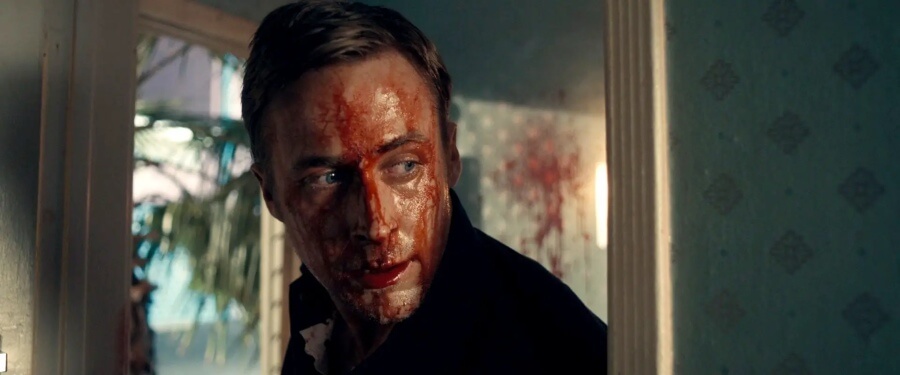
Ryan Gosling in 2011’s Drive
First off, gory movie nerds – don’t get mad if I leave out a perfect classical representation of movie gore from 1963. So many films have iconic blood, and I’m gonna layer in the best that come to mind without opening an ancient tome of bloodlore guarded in a tower by a winged panther.
Quentin Tarantino’s films epitomize paying as much attention to the blood as say, Daniel Day-Lewis does to prepare for a role. Slash Film wrote a Tarantino blood article in 2022 and quoted a 2002 Time Magazine article where Tarantino said this:
I’m really particular about the blood, so we’re using a mixture depending on the scenes. I say, ‘I don’t want horror movie blood, all right? I want Samurai blood.’ You can’t pour this raspberry pancake syrup on a sword and have it look good. You have to have this special kind of blood that you only see in Samurai movies.
The Time article went on to say that Tarantino’s Kill Bill screenplay was specific about when geysers of spurting blood turn “from crimson red to oil black.”
The Artistic Arterial Spray Style, as it is of course technically called by auteurs across the land, does not always have to be ultra-realistic, but it is always at the forefront of the scene and with the pedal smashed to the floor. These films are blood tsunamis that toss audiences about in a gore wave. For example, in Drive, Ryan Gosling stabs a man to death with a curtain rod. Alfred Brooks’ character kills his victims with a fork and a shaving blade. This is a movie designed for fans of grisly violence.
Criteria for Artistic Arterial Spray Style:
- Character death is purposefully over-the-top.
- Fluctuating colors often result in bright, spraying reds.
- Camera lingers an extra beat (or five or six) in every blood scene.
The “Sludge Blood” style
Notables: The Walking Dead, 30 Days of Night, 28 Weeks Later
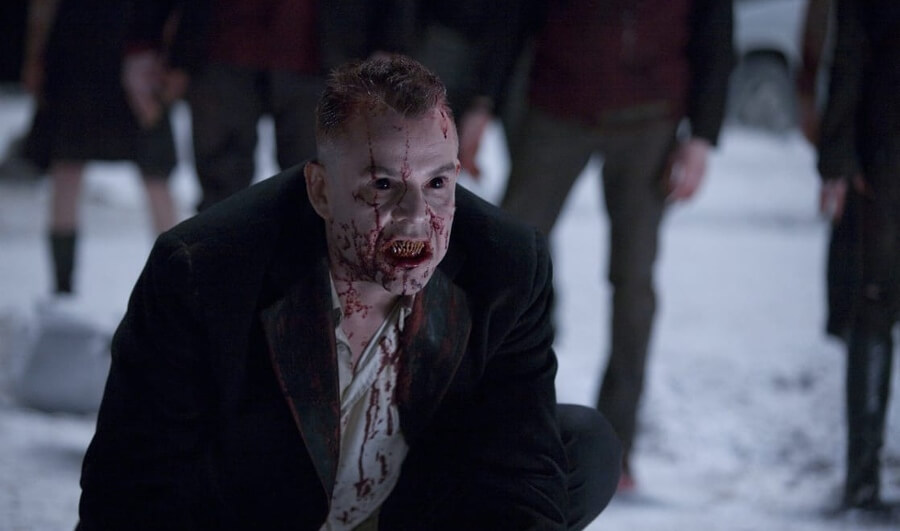
Danny Huston as the vampire Marlow in 30 Days of Night
Sludge Blood Style must have a hypnotic curse over vampire and zombie creators – it is inexplicably a go-to favorite of these genres. At some point, I imagine a producer on The Walking Dead went to a team of scientists and asked, “What does zombie blood look like?” Their reply was, “Black sludge caked around the mouth and drooling like magma from gaping dark chocolate wounds”.
A Business Insider article in 2016 spotlighted the Property Master for The Walking Dead, John Sanders, and how he frequently cleaned up gallons and gallons of fake blood. It also detailed how The Walking Dead utilized about a dozen shades of blood, and which shade used was reliant on the deadness of the “Walker”. The deader the zombie, the darker the blood. In that vein, it makes sense. The body’s rotting, the blood congeals – it makes sense that it oozes out like the inside of a melted Hershey’s bar.
In projects like 28 Weeks Later, the Sludge Blood Style is used to imprint brutality – in one scene, a zombie pokes out a person’s eyes, which then bleed a clearly unrealistic – but stylistically effective – black blood.
Criteria for Sludge Blood:
- Generally in the zombie or vampire genre.
- Depicts a rotting creature.
- Often paired with brutal, animalistic scenes of rage.
The “Red Mist Phenomenon” style
Notable gory movies: Zombieland, Zombieland 2, The Expendables, John Wick franchise
You might also call this the “Kinetic Splatter of Chaos” style. Or the “You’re gonna see about 40 kills in a minute all with realistic exit wounds.”
(Psst! Don’t watch the John Wick kill counter video if you’re not prepared for excessive gore.)
Red Mist Phenomenon blends a playfully egregious level of blood with a drive toward realism. While a movie like Zombieland makes a comic choice to show dripping entrails flopping up into the air as a zombie is run down by a combine tractor, John Wick will condense that exuberant blood down to a small, realistically erupting head wound that you’ll see spray out twenty or thirty times in a club.
Jeff Campbell, a VFX Supervisor who worked on the first John Wick, commented to Yahoo on the franchise’s style choices upon the release of John Wick: Chapter 3:
They wanted us to dial it all back, just a little blood mist and muzzle flashes, he says. These are stunt guys, right? They claim they have seen all these effects before. They’ve witnessed broken limbs, gunshots. They’d sometimes catch us and say: ‘That’s not what a gunshot looks like’ or ‘No, the limbs shouldn’t break like that.’
Criteria for the Red Mist Phenomenon:
- Extremely high henchman body count.
- Often used in action movies with kinetic, chaotic close-ups in tight quarters.
- Sometimes used for cartoonish effect in a horror-comedy.
The “Buckets of Blood” style or “The Gore of Spectacle”
Notable gory movies: The Shining, The Cabin in the Woods, Evil Dead, Fargo
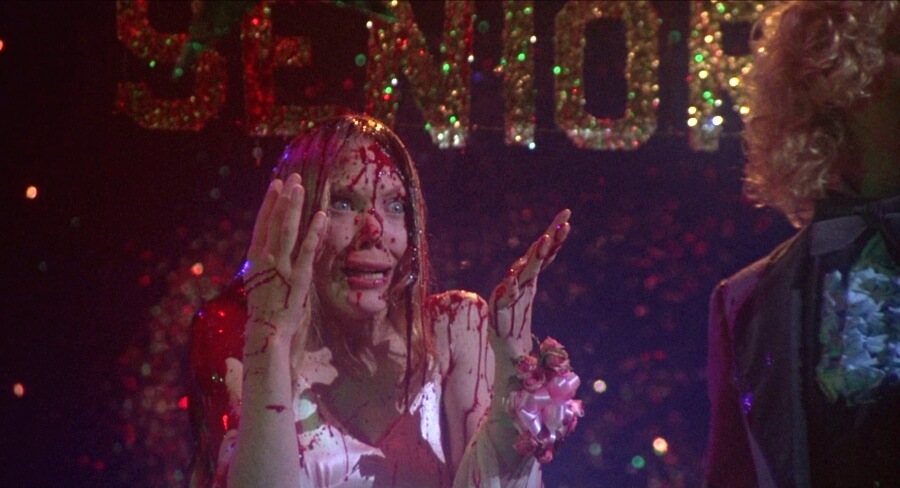
Sissy Spacek is doused with a bucket of (fake) pig’s blood in 1976’s Carrie
Buckets of Blood style is based on spectacle. Yeah, the climactic Carrie scene that doused Sissy Spacek in blood was only a single bucket, but it’s big, pivotal, and iconic. 1996’s Fargo? Not an overall bloody movie. But that wood-chipper scene? Goodness. You don’t forget that.
Fargo wood chipper scene
The Buckets of Blood style is impressive when it’s done with CGI blood. Achieving a practical bloodbath is another level of dedication.
In 2018, Yahoo did an article with Leon Vitali, Stanley Kubrick’s former assistant. Vitali detailed how the entire elevator blood scene in The Shining had to be completed on the first take due to the incredible logistical stress of this kind of scene. From Vitali in the Yahoo interview:
We spent weeks and weeks and weeks trying to get the quality and color of the blood as natural as it could be, says Vitali, now 70. You didn’t want it too red. The consistency was also quite important, because we were pouring out hundreds of gallons of the stuff. And then, of course, there were the mechanics of it, because if you have that much pressure inside something like an elevator, it’s going to blow if you’re not careful.
These original bloody classics influenced future uses of the Buckets of Blood approach. 2012’s The Cabin in the Woods, now a modern horror classic, had one of the most entertainingly bloody climaxes ever with its version of a Shining-like elevator scene. In a 2012 interview with Brad Brevet for ComingSoon, the director of The Cabin in the Woods, Drew Goddard, spoke directly to his influences:
I wanted to beat Stanley Kubrick‘s record but the problem is he did so many takes of that elevator dump they did that we realized about halfway through there was no way we were ever going to top that record. So it was very sad.
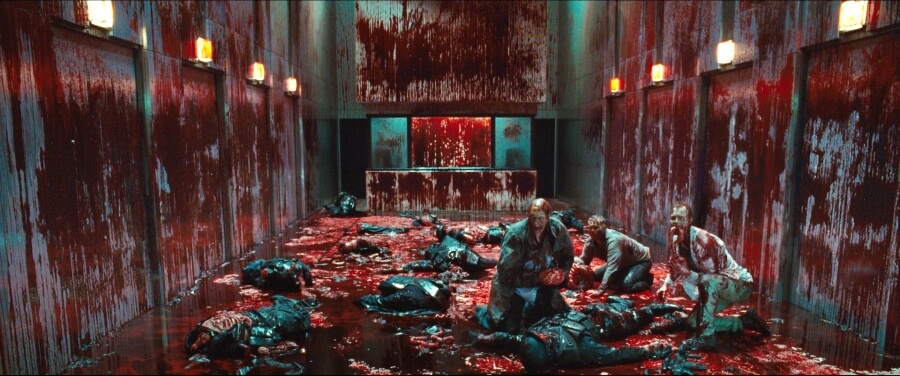
The “elevator scene” from 2012’s The Cabin in the Woods
You could say Evil Dead helped set a mainstream precedent for the Buckets of Blood style with the original in 1981 when Bruce Campbell used a homemade low-budget fake blood recipe. As movie history has evolved, the Buckets of Blood style is largely used for shock value or comedic effect. The newest installment of the Evil Dead franchise premieres theatrically on April 21st, and it appears they decided to up the blood ante: According to Slash Film, Director Lee Cronin stated that they used over 1,700 gallons of fake blood.
Criteria for Buckets of Blood style:
- Usually contained to one gargantuan scene that stands out in a film.
- Sometimes utilized consistently for over-the-top comedic effect (Renfield, What we do in the Shadows).
- Can contain aspects of cult or camp horror, like Evil Dead.
- Meant to leave a lasting iconic horror imprint.
There is no movie without the bloody gore!
It’s true – you tell ‘em, Subheader Title Man with a cockney accent.
Some blood – too unrealistic – completely takes the audience out of the film. Some scenes, like the Army Ranger in Blackhawk Down trying to fix the soldier’s severed artery, make us want to walk out of the room.
Once the scene is in our cinematic consciousness, it lives on in eternal blood lore: James Caan staggering around a tollbooth with Dick Smith’s recipe dripping from him. Rambo self-sewing a shoulder wound in the forest.
It might be a 3D particle specialist like Andy Byrne, splattering a CG model. It might be a makeup artist in a lot trailer, stirring up a good ole batch of food dye and corn syrup. By the end, you have the same thing:
the moments that audiences remember forever.
The original Dick Smith recipe can be poisonous (it calls for Kodak Photo-Flo), but to punctuate this homage to blood, here’s a recipe – used by Bruce Campbell in 1981’s Evil Dead – for those who have no budget but plenty of gory hopes and dreams:
Ingredients (successfully murders two actors):
- Six pints clear Karo syrup
- Three pints red food coloring
- One pint non-dairy creamer
- One drop blue food coloring
Equipment:
- Large ceramic bowl
- Medium-sized bowl
- Spoon
Pour your Karo syrup into the large bowl. Stir the non-dairy creamer in the medium bowl until it turns into a paste. Slowly layer the non-dairy creamer into the syrup. Stir in the red food coloring. Add the drop of blue coloring. Test your blood on a white surface, then go to town.
*The Bruce Campbell recipe originally appeared in his autobiography, “If Chins Could Kill: Confessions of a B Movie Actor”.

